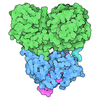[English] 日本語
 Yorodumi
Yorodumi- PDB-7jl3: Cryo-EM structure of RIG-I:dsRNA filament in complex with RIPLET ... -
+ Open data
Open data
- Basic information
Basic information
| Entry | Database: PDB / ID: 7jl3 | ||||||
|---|---|---|---|---|---|---|---|
| Title | Cryo-EM structure of RIG-I:dsRNA filament in complex with RIPLET PrySpry domain (trimer) | ||||||
 Components Components |
| ||||||
 Keywords Keywords | HYDROLASE/TRANSFERASE/RNA /  Innate immunity / Innate immunity /  E3 ligase / E3 ligase /  helicase / antiviral signaling / RLR / dsRNA sensor / HYDROLASE-TRANSFERASE-RNA complex helicase / antiviral signaling / RLR / dsRNA sensor / HYDROLASE-TRANSFERASE-RNA complex | ||||||
| Function / homology |  Function and homology information Function and homology informationRIG-I binding / free ubiquitin chain polymerization / regulation of type III interferon production / RIG-I signaling pathway / positive regulation of myeloid dendritic cell cytokine production / OAS antiviral response / detection of virus / NF-kB activation through FADD/RIP-1 pathway mediated by caspase-8 and -10 / positive regulation of response to cytokine stimulus / positive regulation of granulocyte macrophage colony-stimulating factor production ...RIG-I binding / free ubiquitin chain polymerization / regulation of type III interferon production / RIG-I signaling pathway / positive regulation of myeloid dendritic cell cytokine production / OAS antiviral response / detection of virus / NF-kB activation through FADD/RIP-1 pathway mediated by caspase-8 and -10 / positive regulation of response to cytokine stimulus / positive regulation of granulocyte macrophage colony-stimulating factor production / RSV-host interactions /  pattern recognition receptor activity / TRAF6 mediated IRF7 activation / pattern recognition receptor activity / TRAF6 mediated IRF7 activation /  regulation of innate immune response / cytoplasmic pattern recognition receptor signaling pathway / cellular response to exogenous dsRNA / response to exogenous dsRNA / protein K63-linked ubiquitination / antiviral innate immune response / TRAF6 mediated NF-kB activation / positive regulation of interferon-alpha production / bicellular tight junction / ribonucleoprotein complex binding / regulation of innate immune response / cytoplasmic pattern recognition receptor signaling pathway / cellular response to exogenous dsRNA / response to exogenous dsRNA / protein K63-linked ubiquitination / antiviral innate immune response / TRAF6 mediated NF-kB activation / positive regulation of interferon-alpha production / bicellular tight junction / ribonucleoprotein complex binding /  regulation of cell migration / positive regulation of defense response to virus by host / positive regulation of interferon-beta production / Evasion by RSV of host interferon responses / Negative regulators of DDX58/IFIH1 signaling / positive regulation of interleukin-8 production / response to virus / RING-type E3 ubiquitin transferase / DDX58/IFIH1-mediated induction of interferon-alpha/beta / protein homooligomerization / ISG15 antiviral mechanism / ruffle membrane / cytoplasmic stress granule / protein polyubiquitination / ubiquitin-protein transferase activity / positive regulation of interleukin-6 production / SARS-CoV-1 activates/modulates innate immune responses / positive regulation of tumor necrosis factor production / regulation of cell migration / positive regulation of defense response to virus by host / positive regulation of interferon-beta production / Evasion by RSV of host interferon responses / Negative regulators of DDX58/IFIH1 signaling / positive regulation of interleukin-8 production / response to virus / RING-type E3 ubiquitin transferase / DDX58/IFIH1-mediated induction of interferon-alpha/beta / protein homooligomerization / ISG15 antiviral mechanism / ruffle membrane / cytoplasmic stress granule / protein polyubiquitination / ubiquitin-protein transferase activity / positive regulation of interleukin-6 production / SARS-CoV-1 activates/modulates innate immune responses / positive regulation of tumor necrosis factor production /  ubiquitin protein ligase activity / ubiquitin protein ligase activity /  double-stranded RNA binding / Ovarian tumor domain proteases / double-stranded RNA binding / Ovarian tumor domain proteases /  actin cytoskeleton / TRAF3-dependent IRF activation pathway / actin cytoskeleton / TRAF3-dependent IRF activation pathway /  gene expression / gene expression /  double-stranded DNA binding / defense response to virus / double-stranded DNA binding / defense response to virus /  RNA helicase activity / RNA helicase activity /  single-stranded RNA binding / Ub-specific processing proteases / protein ubiquitination / single-stranded RNA binding / Ub-specific processing proteases / protein ubiquitination /  RNA helicase / RNA helicase /  ribonucleoprotein complex / ribonucleoprotein complex /  innate immune response / innate immune response /  ubiquitin protein ligase binding / positive regulation of gene expression / GTP binding / SARS-CoV-2 activates/modulates innate and adaptive immune responses / ubiquitin protein ligase binding / positive regulation of gene expression / GTP binding / SARS-CoV-2 activates/modulates innate and adaptive immune responses /  ATP hydrolysis activity / positive regulation of transcription by RNA polymerase II / zinc ion binding / ATP hydrolysis activity / positive regulation of transcription by RNA polymerase II / zinc ion binding /  ATP binding / identical protein binding / ATP binding / identical protein binding /  metal ion binding / metal ion binding /  cytosol / cytosol /  cytoplasm cytoplasmSimilarity search - Function | ||||||
| Biological species |   Homo sapiens (human) Homo sapiens (human) | ||||||
| Method |  ELECTRON MICROSCOPY / helical reconstruction / ELECTRON MICROSCOPY / helical reconstruction /  cryo EM / Resolution: 4.2 Å cryo EM / Resolution: 4.2 Å | ||||||
 Authors Authors | Kato, K. / Ahmad, S. / Hur, S. | ||||||
| Funding support |  United States, 1items United States, 1items
| ||||||
 Citation Citation |  Journal: Mol Cell / Year: 2021 Journal: Mol Cell / Year: 2021Title: Structural analysis of RIG-I-like receptors reveals ancient rules of engagement between diverse RNA helicases and TRIM ubiquitin ligases. Authors: Kazuki Kato / Sadeem Ahmad / Zixiang Zhu / Janet M Young / Xin Mu / Sehoon Park / Harmit S Malik / Sun Hur /   Abstract: RNA helicases and E3 ubiquitin ligases mediate many critical functions in cells, but their actions have largely been studied in distinct biological contexts. Here, we uncover evolutionarily conserved ...RNA helicases and E3 ubiquitin ligases mediate many critical functions in cells, but their actions have largely been studied in distinct biological contexts. Here, we uncover evolutionarily conserved rules of engagement between RNA helicases and tripartite motif (TRIM) E3 ligases that lead to their functional coordination in vertebrate innate immunity. Using cryoelectron microscopy and biochemistry, we show that RIG-I-like receptors (RLRs), viral RNA receptors with helicase domains, interact with their cognate TRIM/TRIM-like E3 ligases through similar epitopes in the helicase domains. Their interactions are avidity driven, restricting the actions of TRIM/TRIM-like proteins and consequent immune activation to RLR multimers. Mass spectrometry and phylogeny-guided biochemical analyses further reveal that similar rules of engagement may apply to diverse RNA helicases and TRIM/TRIM-like proteins. Our analyses suggest not only conserved substrates for TRIM proteins but also, unexpectedly, deep evolutionary connections between TRIM proteins and RNA helicases, linking ubiquitin and RNA biology throughout animal evolution. | ||||||
| History |
|
- Structure visualization
Structure visualization
| Movie |
 Movie viewer Movie viewer |
|---|---|
| Structure viewer | Molecule:  Molmil Molmil Jmol/JSmol Jmol/JSmol |
- Downloads & links
Downloads & links
- Download
Download
| PDBx/mmCIF format |  7jl3.cif.gz 7jl3.cif.gz | 585.9 KB | Display |  PDBx/mmCIF format PDBx/mmCIF format |
|---|---|---|---|---|
| PDB format |  pdb7jl3.ent.gz pdb7jl3.ent.gz | 443.9 KB | Display |  PDB format PDB format |
| PDBx/mmJSON format |  7jl3.json.gz 7jl3.json.gz | Tree view |  PDBx/mmJSON format PDBx/mmJSON format | |
| Others |  Other downloads Other downloads |
-Validation report
| Arichive directory |  https://data.pdbj.org/pub/pdb/validation_reports/jl/7jl3 https://data.pdbj.org/pub/pdb/validation_reports/jl/7jl3 ftp://data.pdbj.org/pub/pdb/validation_reports/jl/7jl3 ftp://data.pdbj.org/pub/pdb/validation_reports/jl/7jl3 | HTTPS FTP |
|---|
-Related structure data
| Related structure data |  22371MC  7jl0C  7jl1C  7jl2C  7jl4C C: citing same article ( M: map data used to model this data |
|---|---|
| Similar structure data |
- Links
Links
- Assembly
Assembly
| Deposited unit | 
| ||||||||||||||||||||||||||||||||||||||||||||||||||||||||||||||||||||||||||||||||||||||||||||||||||||||||||||||||||||||||||||||||||||||||||||||||||||||||||||
|---|---|---|---|---|---|---|---|---|---|---|---|---|---|---|---|---|---|---|---|---|---|---|---|---|---|---|---|---|---|---|---|---|---|---|---|---|---|---|---|---|---|---|---|---|---|---|---|---|---|---|---|---|---|---|---|---|---|---|---|---|---|---|---|---|---|---|---|---|---|---|---|---|---|---|---|---|---|---|---|---|---|---|---|---|---|---|---|---|---|---|---|---|---|---|---|---|---|---|---|---|---|---|---|---|---|---|---|---|---|---|---|---|---|---|---|---|---|---|---|---|---|---|---|---|---|---|---|---|---|---|---|---|---|---|---|---|---|---|---|---|---|---|---|---|---|---|---|---|---|---|---|---|---|---|---|---|---|
| 1 |
| ||||||||||||||||||||||||||||||||||||||||||||||||||||||||||||||||||||||||||||||||||||||||||||||||||||||||||||||||||||||||||||||||||||||||||||||||||||||||||||
| Noncrystallographic symmetry (NCS) | NCS domain:
NCS domain segments:
NCS ensembles :
NCS oper:
|
- Components
Components
-Protein , 2 types, 6 molecules ACEBDF
| #1: Protein | Mass: 82724.070 Da / Num. of mol.: 3 / Fragment: UNP residues 159-880 Source method: isolated from a genetically manipulated source Source: (gene. exp.)   Homo sapiens (human) / Gene: DDX58 / Production host: Homo sapiens (human) / Gene: DDX58 / Production host:   Escherichia coli (E. coli) / References: UniProt: O95786, Escherichia coli (E. coli) / References: UniProt: O95786,  RNA helicase RNA helicase#2: Protein | Mass: 21021.904 Da / Num. of mol.: 3 / Fragment: RIPLET PrySpry domain (UNP residues 249-432) Source method: isolated from a genetically manipulated source Source: (gene. exp.)   Homo sapiens (human) / Gene: RNF135, L13 / Production host: Homo sapiens (human) / Gene: RNF135, L13 / Production host:   Escherichia coli (E. coli) Escherichia coli (E. coli)References: UniProt: Q8IUD6, RING-type E3 ubiquitin transferase |
|---|
-RNA chain , 2 types, 2 molecules XY
| #3: RNA chain | Mass: 13550.107 Da / Num. of mol.: 1 / Source method: obtained synthetically / Source: (synth.)   Homo sapiens (human) Homo sapiens (human) |
|---|---|
| #4: RNA chain | Mass: 13360.916 Da / Num. of mol.: 1 / Source method: obtained synthetically / Source: (synth.)   Homo sapiens (human) Homo sapiens (human) |
-Non-polymers , 4 types, 12 molecules 
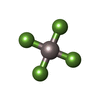





| #5: Chemical |  Adenosine diphosphate Adenosine diphosphate#6: Chemical | #7: Chemical | #8: Chemical | |
|---|
-Details
| Has ligand of interest | N |
|---|
-Experimental details
-Experiment
| Experiment | Method:  ELECTRON MICROSCOPY ELECTRON MICROSCOPY |
|---|---|
| EM experiment | Aggregation state: FILAMENT / 3D reconstruction method: helical reconstruction |
- Sample preparation
Sample preparation
| Component | Name: Ternary complex of dsRNA-bound RIG-I filament with RIPLET PrySpry domain Type: COMPLEX / Entity ID: #1-#4 / Source: RECOMBINANT |
|---|---|
| Source (natural) | Organism:   Homo sapiens (human) Homo sapiens (human) |
| Source (recombinant) | Organism:   Escherichia coli (E. coli) Escherichia coli (E. coli) |
| Buffer solution | pH: 7.5 |
| Specimen | Embedding applied: NO / Shadowing applied: NO / Staining applied : NO / Vitrification applied : NO / Vitrification applied : YES : YES |
| Specimen support | Details: unspecified |
Vitrification | Cryogen name: ETHANE |
- Electron microscopy imaging
Electron microscopy imaging
| Experimental equipment |  Model: Titan Krios / Image courtesy: FEI Company |
|---|---|
| Microscopy | Model: TFS KRIOS |
| Electron gun | Electron source : :  FIELD EMISSION GUN / Accelerating voltage: 300 kV / Illumination mode: FLOOD BEAM FIELD EMISSION GUN / Accelerating voltage: 300 kV / Illumination mode: FLOOD BEAM |
| Electron lens | Mode: BRIGHT FIELD Bright-field microscopy Bright-field microscopy |
| Image recording | Electron dose: 19.424 e/Å2 / Film or detector model: GATAN K3 BIOQUANTUM (6k x 4k) |
- Processing
Processing
| Software |
| ||||||||||||||||||||||||||||||
|---|---|---|---|---|---|---|---|---|---|---|---|---|---|---|---|---|---|---|---|---|---|---|---|---|---|---|---|---|---|---|---|
CTF correction | Type: PHASE FLIPPING AND AMPLITUDE CORRECTION | ||||||||||||||||||||||||||||||
| Helical symmerty | Angular rotation/subunit: 76.1005 ° / Axial rise/subunit: 46.2706 Å / Axial symmetry: C1 | ||||||||||||||||||||||||||||||
3D reconstruction | Resolution: 4.2 Å / Resolution method: FSC 0.143 CUT-OFF / Num. of particles: 39718 / Symmetry type: HELICAL | ||||||||||||||||||||||||||||||
| Refinement | Cross valid method: NONE Stereochemistry target values: GeoStd + Monomer Library + CDL v1.2 | ||||||||||||||||||||||||||||||
| Displacement parameters | Biso mean: 98.75 Å2 | ||||||||||||||||||||||||||||||
| Refine LS restraints |
| ||||||||||||||||||||||||||||||
| Refine LS restraints NCS |
|
 Movie
Movie Controller
Controller







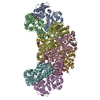

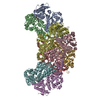
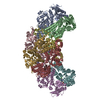


 PDBj
PDBj





































